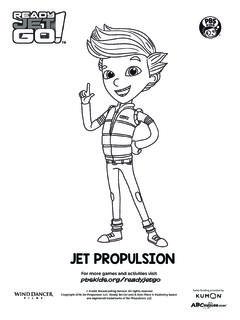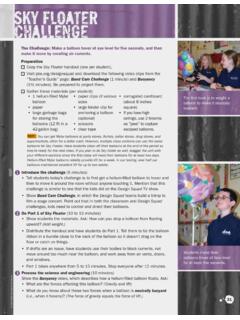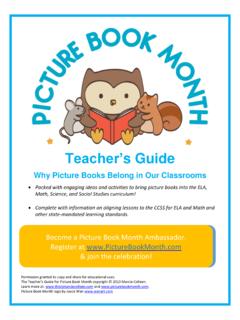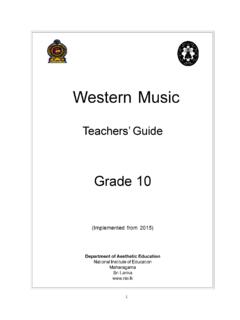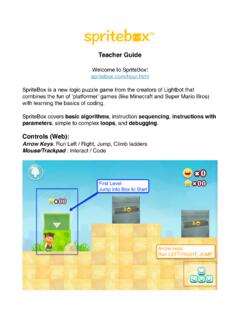Transcription of TEACHER'S GUIDE - PBS Kids
1 TEACHER'S GUIDEHANDS-ON ENGINEERING CHALLENGES TO BOLSTER YOUR ELECTRICITY, SOUND, AND FORCE UNITSFOR MIDDLE SCHOOL SCIENCE AND TECHNOLOGY CLASSROOMSDear Teachers,Intel welcomes you to the Emmy and Peabody Award-winning PBS series, design squad ! Our sponsorship of design squad is an important component of our commitment to education and to inspiring tomorrow s innovators. Intel believes that young people are the key to solving global challenges. design squad s substantive focus on math, science, and the design process is closely aligned with our mission of engaging young people s curiosity and developing their critical thinking and problem-solving skills. We believe that design squad s ability to bring innovation to life by showcasing engaging, real-life applications of engineering will increase students interest in the subject and in creative careers that turn science into reality.
2 We encourage you to use this design squad teacher s GUIDE in concert with the television series and the media-rich Web site to help your students investigate and solve challenging problems that just may change the world. Sincerely,Shelly EsquePresident, Intel Foundation 2009 WGBH Educational squad goes to school! This GUIDE is written especially for middle school teachers of science, technology, engineering, and mathematics (STEM). Its hands-on, standards-based activities focus on force, electricity, and sound topics found in nearly every physical science curriculum. In the process of tackling the GUIDE s open-ended challenges, students develop a working understanding of core science concepts, deepen their understanding of the design process, and increase their motivation to learn science, technology, engineering, and the design Process 2 How to Use This GUIDE 4 UNIT 1: ELECTRIFYING GAMES Explore circuits by designing a pinball-style game with motors and Games unit overview 5 Kick Stick teacher notes and student handout 6 Electric Gamebox teacher notes and student handout 10 Making It Real: Driving Home the Electrifying Games Unit 14 UNIT 2.
3 SOUNDS GOODE xplore sound by making stringed instruments and rockin Good unit overview 16 String Thing teacher notes and student handout 17 Build a Band teacher notes and student handout 19 Headphone Helper teacher notes and student handout 23 Making It Real: Driving Home the Sounds Good Unit 27 UNIT 3: BREEZY BLIMPS Explore Newton s Laws, force, and air pressure by making blimps out of Blimps unit overview 30 Sky Floater teacher notes and student handout 31 Sky Glider teacher notes and student handout 35 Blimp Jet teacher notes 39 Making It Real: Driving Home the Breezy Blimps Unit 41 APPENDIXU sing design squad Media Resources 43 Performance Assessment Rubric 44 Materials List 45 More design squad Challenges 46 Related Science Resources 47 Education Standards 48 TABLE OF CONTENTSC ompetition plus engineering equals fun!
4 design squad gets kids thinking like engineers and shows them that engineering can be fun, creative, and something they can do. Watch it on PBS and visit the Web site to get episodes, games, dozens of hands-on challenges, and much this GUIDE to deepen students understanding of science concepts and the engineering design process, provide opportunities for teamwork and hands-on problem solving, and present engineers as creative problem solvers who design things that matter and improve people s initial ideas rarely solve a problem. Instead, they try different ideas, learn from their mistakes, and then try again. The steps engineers use to arrive at a solution are called the design process. As students work through a challenge, use the questions below to tie their work to specifi c steps of the design process. BRAINSTORMWhat are some different ways to tackle today s challenge?
5 Off-the-wall suggestions often spark GREAT ideas. How creative can you be? DESIGNW hich brainstormed ideas are really possible, given your time, tools, and materials?What are some problems you need to solve as you build your project?How can a sketch help clarify your design ? BUILDWhat materials will you need? What can you learn by looking at other students projects?TEST, EVALUATE, AND REDESIGNINTRODUCING THE design PROCESSThe design process is a great way to tackle almost any task. In fact, you use it each time you create something that didn t exist before ( , planning an outing, cooking a meal, or choosing an outfi t).Why is it a good idea to keep testing a design ? What specifi c goal are you trying to achieve, and how will you know if you ve been successful?How does the design meet the criteria for success presented in the challenge?
6 SHARE SOLUTIONSWhat s the best feature of your design ? Why? What were the different steps you did to get your project to work? What was the hardest problem to solve? Did you have to do something a few times to get it to work? What? If you had more time, how would you improve your project? APPLYING THE design PROCESSThe design process is built into each challenge. As students work through a challenge, they ll see that the steps of the design process encourage them to think creatively to solve a problem. Engineering activities tend to allow for more creativity and differences in thinking than science labs. They ask students to be creative, problem solve, and work directly with materials. Rosemary B. Fairgrounds Middle School Nashua, NH 2009 WGBH Educational CLIPS OF THE design PROCESS IN ACTIONT here is a short video clip of each design process step on the design squad Web site.
7 By watching the design squad teams work through each step of the design process, students will learn to think creatively when solving a problem and strengthen their critical-thinking abilities. Also, if your class is struggling with any particular step or with group dynamics, these videos offer a convenient way to talk through an issue. Download the clip(s) you want from the teacher s GUIDE page at the Problem (1 minutes)Understanding the problem paves the way for solving it. This clip lets you emphasize to students the importance of defi ning the challenge(s) clearly before getting started. As a class, discuss how the design squad teams prepare to design and build furniture out of (1 minutes)Coming up with many possible solutions is a powerful way to begin a project. This clip shows design squad teams generating lots of ideas for devices that a dancer can use in an underwater performance.
8 As a class, discuss what made this brainstorm successful. design (1 minute)Now it s time to choose the best solution and plan how to build it. In this clip, the design squad teams squabble about when to stop designing and start building their specialized bikes. As a class, discuss possible solutions for moving a team forward when there is , Test, Evaluate, and Redesign (1 minute)Once kids settle on a design , it s time to build, test, and redesign it. This clip shows that things don t always work as planned. As a class, discuss how the design squad teams learn from their testing results and fi gure out how to redesign and make Solutions (2 minutes)Presenting one s work to others is a constructive way to conclude a project. As a class, discuss how the design squad team s presentation validates the team s work, places it in a broader context, and lets the team members refl ect on how effectively they communicated and YOUR SKILLSB uild your skills and confi dence in guiding students through engineering activities using the design process.
9 Through this free, self-guided, NASA design squad online training, you ll see what the design process looks like in the classroom, learn a host of implementation strategies, and experience the fun and relevance of engineering. Find it at: the design squad teams model the steps of the design process for your students. Download these fi ve brief videos from the teacher s GUIDE page at 2009 WGBH Educational GUIDE will help you integrate standards-based design challenges into your science, technology, engineering, and mathematics (STEM) WITH THE UNIT OVERVIEWEach unit opens with an overview that describes the activities and shows how they can enrich your curriculum and target what you want your students to learn. Use the overview to choose the challenge(s) that fi t your curricular goals and the time you have available.
10 Each challenge is designed to take 50 THE EASY-TO-USE teacher NOTESP reparation: Lists things to do to get ready for the the challenge: Presents the challenge and puts it in a design squad context by having students watch a short, relevant video clip from the : Identifi es the activity s key elements and offers talking points to jump-start student thinking about ways to meet the challenge and apply related science the problem to solve: Asks students to identify the specifi c tasks they ll need to accomplish in the class period and to consider how to order them. This pre-planning helps students make effective use of class , test, and redesign: Lists issues that might surface during a challenge and suggests strategies you can use with students who face these THE STUDENT HANDOUTNate Ball is a mechanical engineer and the 20-something host of design squad .

